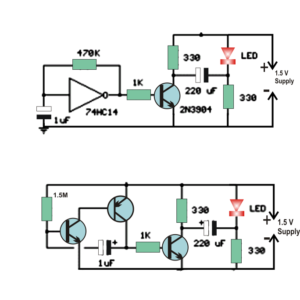This LED flasher circuit requires only 1.5V to flash an LED lamp and therefore can be operated using a single 1.5V AAA cell.
The upper circuit, shows utilizing a 100uF capacitor to twofold the battery voltage to get 3 volts for the LED.
How the Circuit Works
Two segments of a 74HC04 hex inverter are utilized as a squarewave oscillator that determines the flashing rate while a third stage is utilized as a soft start that charges the capacitor in arrangement with a 470 ohm resistor, while the support yield is at +1.5 volts.
At the point when the slow start yield changes to ground (zero volts) the charged capacitor is put in arrangement with the LED and the battery which supplies enough voltage to light up the LED.
The LED current is more or less 3 uF, so a high watt LED is suggested.
In the other circuit, the same voltage multiplying standard is utilized with the upgrading the transistor to permit the capacitor to provide speedier supply higher current (around 40mA crest).
A bigger capacitor (1000uF) in arrangement with a 33 ohm resistor would expand the glimmer length of time to around 50mS.
The discrete 3 transistor circuit at the lower right would require a resistor (around 5K) in arrangement with the 1uF capacitor to increase the flashing pulse width.

Comments
where can I buy all these things ?
The description does not match the actual circuit diagrams. For the 1st circuit you talk about THREE hex inverters but only one is drawn. You mention a 470 Ohm resistor but the diagram shows 470 KOhm. What is “the drove” ? What about a “Mama” never heard of that?
In the 2nd circuit (three discrete transistors) you mention a 5KOhm resistor in series with a 1uF capacitor but the diagram shows a 1K resistor. You also mention about a bigger capacitor of 1000uF with a 33 Ohm resistor but the diagram shows 330 Ohm resistors and a 220uF capacitor.
thanks for the pointer, I did the corrections as much as possible,